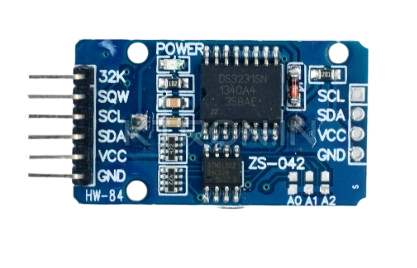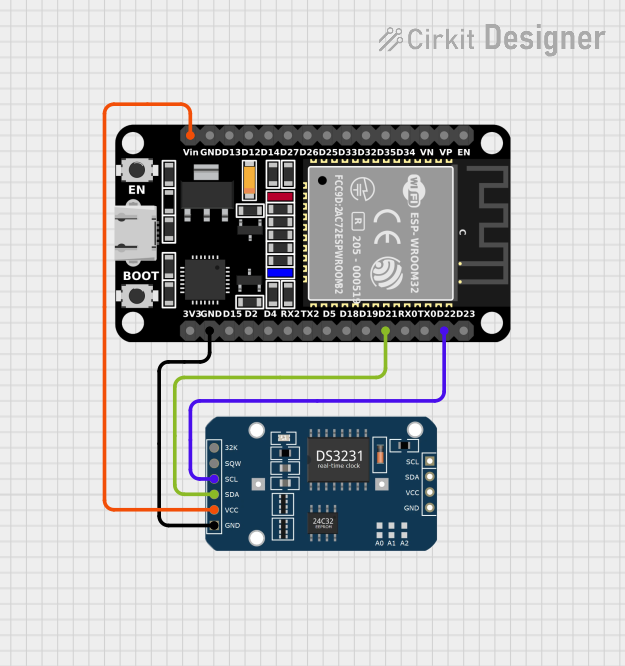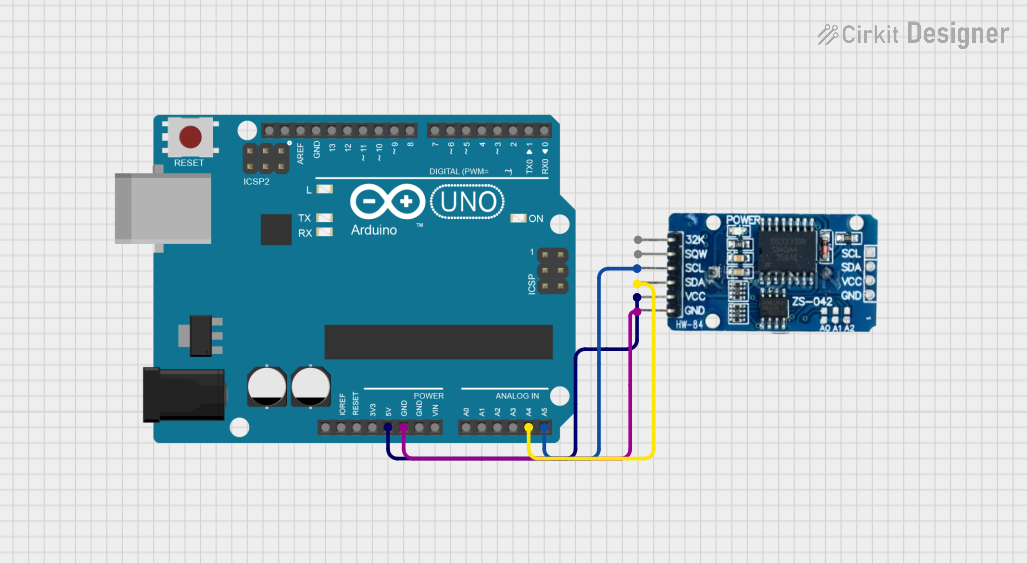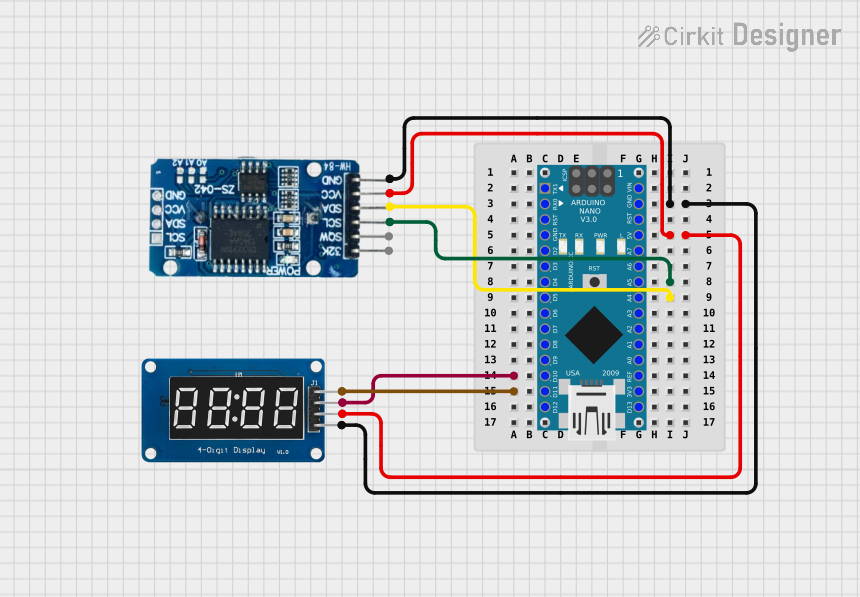
How to Use RTC DS3231: Examples, Pinouts, and Specs

 Design with RTC DS3231 in Cirkit Designer
Design with RTC DS3231 in Cirkit DesignerIntroduction
The DS3231 is a highly accurate real-time clock (RTC) module with an I2C interface. It is designed to keep track of time (hours, minutes, seconds) and date (day, month, year) even during power outages, thanks to its onboard backup battery support. The module features a temperature-compensated crystal oscillator (TCXO), ensuring exceptional accuracy with a drift of only ±2 minutes per year.
Explore Projects Built with RTC DS3231

 Open Project in Cirkit Designer
Open Project in Cirkit Designer
 Open Project in Cirkit Designer
Open Project in Cirkit Designer
 Open Project in Cirkit Designer
Open Project in Cirkit Designer
 Open Project in Cirkit Designer
Open Project in Cirkit DesignerExplore Projects Built with RTC DS3231

 Open Project in Cirkit Designer
Open Project in Cirkit Designer
 Open Project in Cirkit Designer
Open Project in Cirkit Designer
 Open Project in Cirkit Designer
Open Project in Cirkit Designer
 Open Project in Cirkit Designer
Open Project in Cirkit DesignerCommon Applications and Use Cases
- Timekeeping in embedded systems
- Data logging with timestamps
- Alarm and timer functionalities
- Home automation systems
- IoT devices requiring precise time synchronization
Technical Specifications
Key Technical Details
- Operating Voltage: 2.3V to 5.5V
- Timekeeping Accuracy: ±2 minutes per year (at 0°C to +40°C)
- Interface: I2C (2-wire)
- Backup Battery Support: CR2032 coin cell (not included in all modules)
- Temperature Range: -40°C to +85°C
- Additional Features:
- Two programmable alarms
- Square-wave output (1Hz, 4kHz, 8kHz, or 32kHz)
- Built-in temperature sensor with ±3°C accuracy
Pin Configuration and Descriptions
The DS3231 module typically has 6 pins. Below is the pinout and description:
| Pin | Name | Description |
|---|---|---|
| 1 | GND | Ground connection |
| 2 | VCC | Power supply (2.3V to 5.5V) |
| 3 | SDA | Serial Data Line for I2C communication |
| 4 | SCL | Serial Clock Line for I2C communication |
| 5 | SQW/OUT | Square-wave output or interrupt output (programmable frequency) |
| 6 | 32K | 32kHz output (optional, not always used in basic applications) |
Usage Instructions
How to Use the DS3231 in a Circuit
- Power the Module: Connect the VCC pin to a 3.3V or 5V power source and the GND pin to ground.
- I2C Communication: Connect the SDA and SCL pins to the corresponding I2C pins on your microcontroller (e.g., Arduino UNO: SDA = A4, SCL = A5).
- Backup Battery: Insert a CR2032 coin cell battery into the battery holder to maintain timekeeping during power outages.
- Optional Outputs: Use the SQW/OUT pin for square-wave signals or alarms, and the 32K pin for a 32kHz clock signal if required.
Important Considerations and Best Practices
- Ensure proper pull-up resistors (typically 4.7kΩ) are connected to the SDA and SCL lines for I2C communication.
- Avoid shorting the battery holder terminals to prevent damage to the module.
- Use a decoupling capacitor (e.g., 0.1µF) near the VCC pin to stabilize the power supply.
- If using the module with a 5V microcontroller, ensure it is compatible with the DS3231's I2C voltage levels.
Example Code for Arduino UNO
Below is an example of how to interface the DS3231 with an Arduino UNO to read the current time and date:
#include <Wire.h>
#include <RTClib.h> // Include the Adafruit RTClib library
RTC_DS3231 rtc; // Create an RTC object
void setup() {
Serial.begin(9600); // Initialize serial communication
Wire.begin(); // Initialize I2C communication
if (!rtc.begin()) {
Serial.println("Couldn't find RTC. Check connections!");
while (1); // Halt execution if RTC is not found
}
if (rtc.lostPower()) {
Serial.println("RTC lost power, setting the time...");
// Set the RTC to the current date and time
rtc.adjust(DateTime(F(__DATE__), F(__TIME__)));
}
}
void loop() {
DateTime now = rtc.now(); // Get the current time and date
// Print the current time in HH:MM:SS format
Serial.print(now.hour());
Serial.print(':');
Serial.print(now.minute());
Serial.print(':');
Serial.print(now.second());
Serial.print(" ");
// Print the current date in YYYY-MM-DD format
Serial.print(now.year());
Serial.print('-');
Serial.print(now.month());
Serial.print('-');
Serial.println(now.day());
delay(1000); // Wait for 1 second before updating
}
Notes on the Code
- The
RTCliblibrary is required for this example. Install it via the Arduino Library Manager. - The
rtc.adjust()function sets the RTC to the current system time. This is only needed if the RTC loses power or is being initialized for the first time.
Troubleshooting and FAQs
Common Issues and Solutions
RTC Not Detected:
- Cause: Incorrect wiring or missing pull-up resistors on SDA/SCL lines.
- Solution: Double-check the connections and ensure pull-up resistors are in place.
Incorrect Time/Date:
- Cause: RTC lost power or was not initialized properly.
- Solution: Use the
rtc.adjust()function to set the correct time and date.
No Output on Serial Monitor:
- Cause: Serial communication not initialized or incorrect baud rate.
- Solution: Ensure
Serial.begin(9600)matches the baud rate in the Serial Monitor.
Backup Battery Not Working:
- Cause: Dead or improperly inserted battery.
- Solution: Replace the CR2032 battery and ensure it is inserted correctly.
FAQs
Q: Can the DS3231 work without a backup battery?
A: Yes, but it will lose timekeeping functionality during power outages.Q: What is the I2C address of the DS3231?
A: The default I2C address is0x68.Q: How accurate is the DS3231?
A: The DS3231 is accurate to within ±2 minutes per year under typical conditions.Q: Can I use the DS3231 with a 3.3V microcontroller?
A: Yes, the DS3231 is compatible with both 3.3V and 5V systems.
By following this documentation, you can effectively integrate the DS3231 RTC module into your projects for precise timekeeping and scheduling tasks.